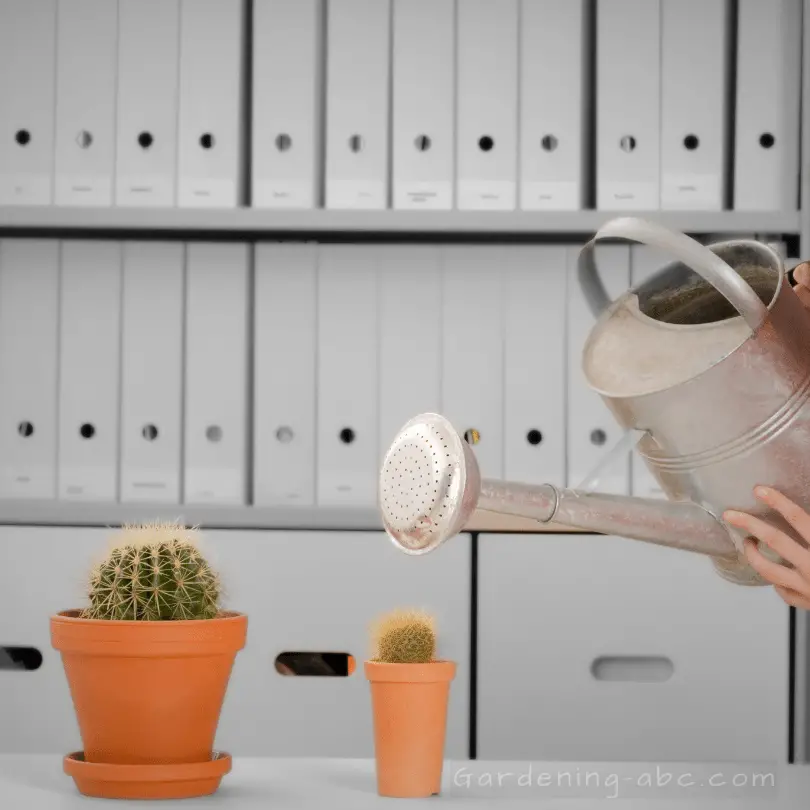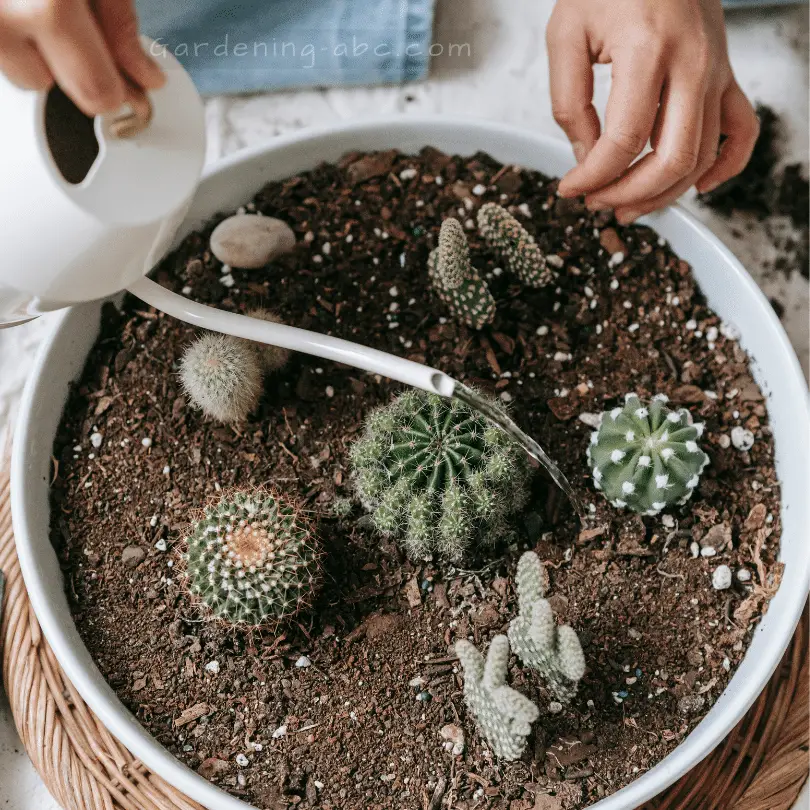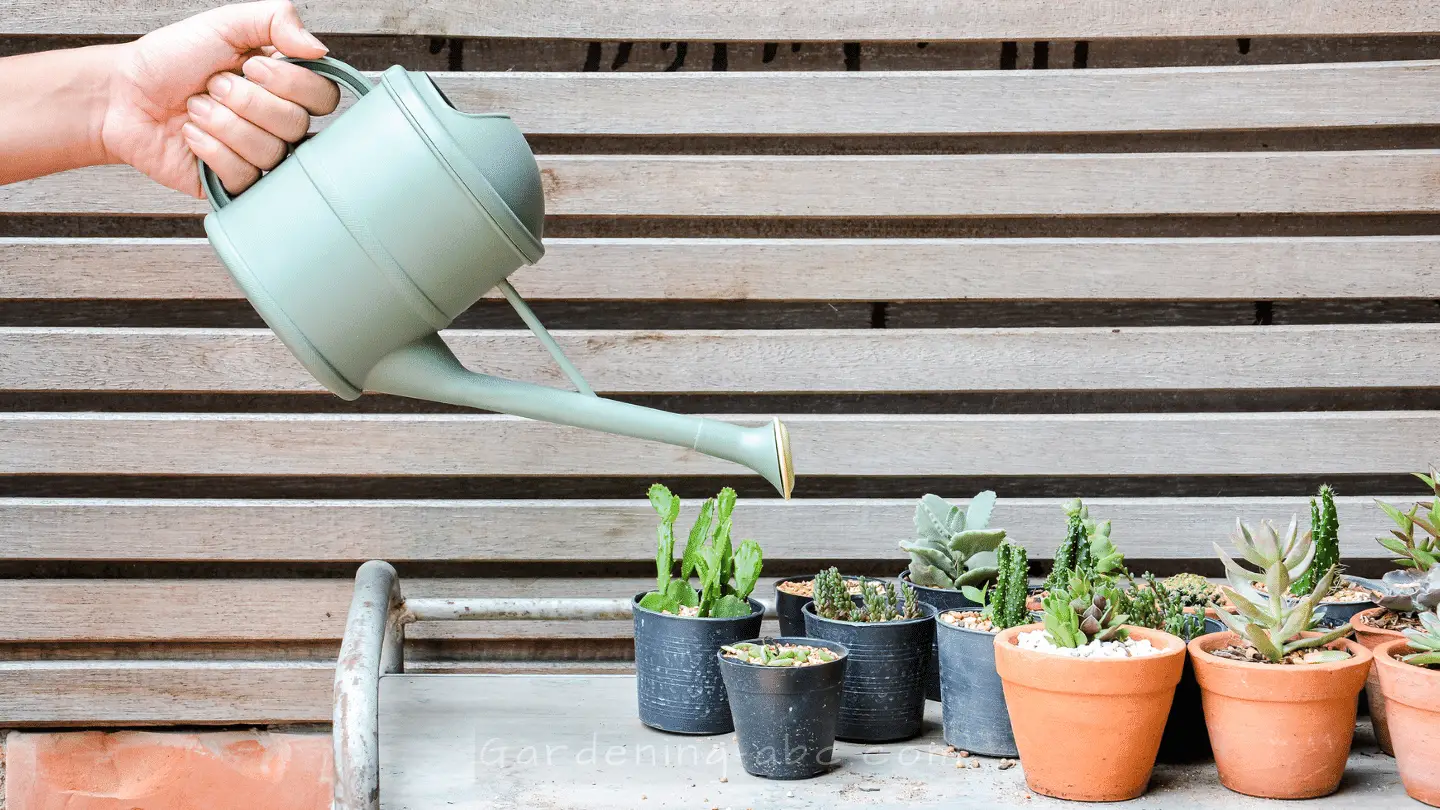We use affiliate links to run our site. When you buy through links on our site, we may earn an affiliate commission, without any added cost to you. Learn more
Are you struggling to determine the ideal watering routine for your cacti, unsure of how often to water them? Put your worries to rest as we unveil the secret to successful cactus care: the soak-and-dry method.
Experience the remarkable transformation of your cacti into vibrant and resilient plants that thrive in any environment. Confidently meet the hydration needs of your prickly companions, and know precisely when to quench their thirst. It’s time to demystify the mysteries of watering cacti and unlock the transformative power of the soak-and-dry method.
Within this comprehensive guide, we will reveal the secrets of this proven watering technique, empowering you to nurture your cacti like a seasoned horticulturist. From understanding the unique challenges associated with cacti to mastering the art of managing soil moisture, we will equip you with the knowledge to become a virtuoso in cactus care.
If you are ready to embark on a journey of plant parenthood that promises lush and healthy cacti, join us as we delve into the wonders of cactus watering. Say goodbye to wilted and overwatered cacti, and welcome a thriving desert oasis into your home.
Understanding Cactus Watering Needs
Before we dive into the specifics of watering, it’s essential to understand the fundamental principles behind a cactus’s water requirements. Unlike many other plants, cacti have adapted to survive in drought-like conditions by storing water in their fleshy stems and leaves. This adaptation allows them to endure extended periods of dryness without suffering from dehydration.
Overwatering a cactus can be just as detrimental as underwatering it. Excessive moisture can lead to root rot and other issues, while insufficient water can cause dehydration and hinder growth. Finding the right balance is crucial to maintaining a healthy and thriving cactus.
Why Watering A cactus is So Difficult?
There are several reasons that make watering a cactus more difficult than other common houseplants:
Different watering needs: Cacti have unique watering requirements compared to other houseplants. They are native to desert environments and have adapted to survive in arid conditions.
Cacti store water in their fleshy stems and roots to sustain them during dry periods. This means they don’t need to be watered as frequently as other plants.
Many plant owners are used to more frequent watering schedules, so adjusting to the sparse watering needs of cacti can be challenging.
Risk of overwatering: There is always a risk of Overwatering your cactus. Since they store water, they are susceptible to root rot and other issues caused by excess moisture.
Overwatering can lead to the roots becoming waterlogged, which can eventually cause the cactus to rot and die.
Finding the right balance between providing enough water to keep the cactus healthy and avoiding overwatering can be tricky.
Lack of visual cues: Unlike some plants that visibly wilt or show signs of distress when they need water, cacti may not exhibit obvious signs of thirst.
They have evolved to conserve water, so they can appear healthy even when they are in need of watering. This makes it challenging to determine when a cactus actually needs water.
Seasonal variations: The watering needs of cacti can also vary depending on the season. During their active growth period, typically in spring and summer, cacti require more frequent watering.
However, during their dormant or inactive period, usually in fall and winter, they need less water. Adjusting the watering frequency according to the changing seasons adds another layer of complexity.
Individual differences: Each cactus species and even individual plants within the same species can have slightly different watering needs. Factors such as the size of the plant, pot size, humidity levels, and environmental conditions can all influence how often a cactus should be watered.
It requires observation and understanding of the specific needs of the cactus in question.
Factors Influencing Cactus Watering Frequency
Several factors influence how often you should water your cactus. By considering these factors, you can develop a watering routine that suits your specific plant’s needs:

1. Cactus Type
There is a vast variety of cacti, each with its own water requirements. Desert cacti, such as the Saguaro or the Golden Barrel, typically require less frequent watering due to their ability to store significant amounts of water.
On the other hand, forest cacti, like the Christmas Cactus or the Easter Cactus, need more regular watering as they originate from environments with higher humidity levels.
Researching your cactus species and understanding its native habitat will provide valuable insights into its watering needs.
2. Season and Climate
Seasonal changes and climate play a crucial role in determining how often you should water your cactus. During the warmer months or in hot and dry climates, cacti tend to require more frequent watering. Conversely, in cooler months or if you live in a more humid region, watering can be reduced.
Pay attention to temperature fluctuations and adjust your watering schedule accordingly to accommodate the changing needs of your cactus.
3. Pot Size and Drainage
The size of the pot and its drainage capabilities directly affect how often you should water your cactus. Cacti prefer well-draining soil to prevent waterlogging, as excessive moisture can lead to root rot. Opt for pots with drainage holes and use a well-draining soil mix specifically designed for cacti and succulents.
Smaller pots tend to dry out more quickly, requiring more frequent watering, while larger pots retain moisture for longer periods.
4. Growth Stage
Cacti go through different growth stages, which can impact their water requirements. During the active growth phase, typically occurring in spring and summer, cacti may need more water to support their increased metabolic activity.
In contrast, during the dormant period in fall and winter, cacti require less water as they enter a rest phase.
Observe your cactus closely and adjust the watering frequency accordingly, keeping in mind its current growth stage.
Practical Tips for Watering Your Cactus
Now that we have a better understanding of the factors influencing cactus watering, let’s explore some practical tips to help you establish a proper watering routine:

- The “Soak and Dry” Method: The soak and dry method is a watering technique commonly used for cacti and other succulent plants. This widely recommended technique involves thoroughly watering the cactus until water drains out of the bottom of the pot. Allow the soil to dry out completely before watering again. This approach mimics the natural rainfall patterns in arid regions, promoting healthy root growth.
- Watering Frequency: As a general rule of thumb, cacti should be watered every 1-2 weeks during the active growing season. However, this can vary depending on the factors mentioned earlier. Always check the moisture level of the soil before watering to avoid overwatering.
- Watering Techniques: When watering, aim to saturate the soil evenly, ensuring that water reaches the entire root system. Avoid splashing water on the cactus’s body or spines, as this can lead to rot and other issues. Water in the early morning or late afternoon to minimize evaporation and allow excess moisture to dry before cooler evening temperatures.
- Observation and Adjustments: Keep a close eye on your cactus and monitor its response to your watering routine. Signs of underwatering include shriveled or wrinkled stems, while overwatering may cause yellowing or softening of the cactus. Adjust the watering frequency accordingly to maintain a healthy balance.
- Seasonal Adjustments: As seasons change, adapt your watering schedule to match the shifting needs of your cactus. Reduce watering in winter, especially if your cactus enters a dormant phase. Increase watering during hot summers or if you live in a dry climate.
Follow these essential tips for growing cacti at home
How Can I Save A Drowning Cactus:
Caring for a cactus requires proper knowledge and attention, especially when it comes to preventing root rot and waterlogging. Follow these steps to rejuvenate your cacti again:
1: Removing the Cactus from Its Pot
To initiate the rescue operation, the first imperative step is to delicately remove the cactus from its pot, taking utmost care not to inflict further harm upon its precious roots. By proceeding cautiously, you can safeguard the plant’s foundation and set the stage for a successful recovery.
2: Discarding Soggy Soil
Next, it is crucial to eliminate the excess moisture that has plagued your cactus. Begin by gently shaking off the surplus soil clinging to the roots, making sure to discard any damp or mushy soil. This diligent process aims to eradicate as much waterlogged soil as possible, effectively preventing the progression of rot.
3: Inspecting the Roots
A thorough examination of the roots is paramount to identifying the extent of the damage caused by root rot. Healthy roots should exhibit firmness and possess a pristine white coloration. Be vigilant and scrutinize the roots for any indication of blackness, brownness, or mushiness, as these are clear signs of root decay and require immediate attention.
4: Trimming the Rotting Roots
To rectify the situation, equip yourself with clean and sterilized shears or scissors to effectively excise the affected segments of the roots. Carefully trim away the decaying sections until you reach the threshold of healthy, white tissue. Remember to sterilize your tools after each cut to minimize the risk of disease transmission.
5: Allowing the Cactus to Dry
Grant your cactus and its roots a period of respite by allowing them to air dry for approximately a week. Placing the plant in a warm and well-ventilated environment can expedite the drying process. This vital step is instrumental in nurturing the remaining healthy roots, promoting their rejuvenation, and thwarting further issues associated with excessive moisture.
6: Repotting the Cactus
Now that your cactus has undergone the necessary drying phase, it is time to provide it with a fresh start. Choose a new pot that offers adequate drainage capabilities.
Fill the container with a blend of well-draining cactus soil or a mixture of potting soil and perlite, ensuring improved water circulation.
When repotting, take care to spread out the roots, avoiding overcrowding. Gently add soil around the roots, firmly securing the cactus in its new abode.
7: Delaying Watering
Upon completion of the repotting process, restrain yourself from immediately watering the cactus. Allow a grace period of one week or until you observe signs of new root growth. This interlude enables the plant to recuperate fully while mitigating the risk of overwatering, a common pitfall in cactus care.
8: Adjusting the Watering Routine
Moving forward, it is crucial to fine-tune your watering routine to maintain the well-being of your rescued cactus. Embrace the “soak and dry” method outlined in the provided article, which serves as a reliable watering guideline.
Thoroughly water the cactus, allowing the excess moisture to drain through the pot’s drainage holes. Exercise patience and wait until the soil is nearly dry before rewatering, ensuring the ideal balance of hydration and preventing the recurrence of water-related issues.
By following these steps and providing proper care, you can give your cactus the best chance to recover from root rot and drowning.
Conclusion
Congratulations! You now possess the knowledge to unlock the full potential of your cacti. Remember, cacti are resilient creatures, but they require a delicate balance when it comes to watering.
Understanding how often to water your cactus is key to its overall health and well-being. By considering factors such as cactus type, season and climate, pot size and drainage, and growth stage, you can tailor a watering routine that meets your cactus’s specific needs.
By following this method, you will ensure your spiky companions receive the precise amount of hydration they need to thrive.
We encourage you to share this guide with fellow plant enthusiasts who could also benefit from this knowledge. And don’t forget to explore more informative articles on our website to deepen your understanding of indoor gardening, outdoor living, and various other topics.
Amazon and the Amazon logo are trademarks of Amazon.com, Inc, or its affiliates.

Hi there! My name is Prasenjit and I’m an avid gardener and someone who has grown a passion for growing plants. From my hands-on experience, I have learned what works and what doesn’t. Here I share everything I have learned.
